- Home
- Sustainability
- Environment
- Responding to Climate Change
- Adaption to Climate Change
Adaption to Climate Change
Basic Policy
In recent years, large-scale natural disasters such as earthquakes, flood, and typhoons, have increased, and they are causing significant economic damages and are ultimately threatening our society and way of life. Such damage from a major earthquake, windstorm, flood, or other natural disaster could also result in significant costs arising from restoring operations at facilities, verifying the safety of delivered housing products, delays in the completion and handover of contracted properties, or other events. These costs could influence Sumitomo Forestry Group's operating results and financial position.
As countermeasures, Sumitomo Forestry promotes the sale of homes built with highly seismic resistant BF construction method as well as the sale of resilience housing equipped with the functionality to sustain living for a certain period of time even if lifelines are cut. Furthermore, we are building a service framework that aims to provide rapid assistance through IoT technology that rapidly grasps the damage during a disaster in real time.
Internal Systems to Adapt to Climate Change
Initiatives of the Disaster Prevention Department
Disaster Recovery Guidelines were put in place in the Housing Division and measures and action guidelines for operations were defined to quickly and accurately respond to damages from natural disasters to our home owners as they become more prevalent due to climate change. As one of the measures, the Disaster Prevention Department, established in 2020, has instructed each branch and Group companies to implement disaster prevention measures on a regular basis. In the event of an emergency, we will direct relevant departments and affiliates and work to minimize the damage caused by disasters.
In response to the Noto Peninsula earthquake, which occurred in January 2024, we established the Hokuriku Disaster Recovery Center and conducted inspections and repair work on the homes of customers affected by the disaster. Additionally, in response to the heavy rainfall in Oku-Noto that occurred in September, we worked together with our branches to provide emergency support to the homes of customers affected by the disaster.
IoT Utilization for Disaster Recovery Support
Issues in Promptly Grasping the Disaster Situation
While Japan has experienced many earthquakes, in recent years, climate change has made natural disasters more severe with intense rainstorms, typhoons and other natural disasters causing extensive and frequent damage. In monetary terms, the total cost of damage caused by natural disasters in Japan from 1991 to 2018 reached $446.63 billion*.
The bigger the disaster, the longer the recovery efforts, and it now takes more time to assess the situation as well. For the Kumamoto earthquake that occurred in April 2016, it took about one and a half months for the government to conduct emergency safety assessment of buildings aimed to prevent secondary disasters. Disaster victims expressed their anxieties as "it takes too much time to get the information we need", which highlights one of the biggest hurdles in speedy recovery efforts.
*Created by The Small and Medium Enterprise Agency using the Centre for Research on the Epidemiology of Disasters database (EM-DAT)
Quickly Gathering Data About Damaged Homes Using Sensing Technologies
Sumitomo Forestry is responding to such issues by developing services that promote quick recovery after disasters. Since 2017, we have been working on proving test of an IoT service that utilizes the analysis technology using sensor to measures, collects, and analyzes the condition of buildings. We place several sensors throughout a house to acquire data, such as the magnitude of an earthquake's tremors, flooding or other conditions, and gather this data through a network to analyze. At our Tsukuba Research Institute, we combine this data with the vast amount of seismic resistance data of wooden houses to facilitate high-precision analysis.
By December 2024, the program has been deployed in 98 locations nationwide, and data is being collected on an ongoing basis. In addition, the system for automatically assessing the degree of damage to buildings has been developed, and we are currently conducting verification using the collected data. We will continue to study the practical application of this new service to protect the safety and security of our customers in the event of a disaster.
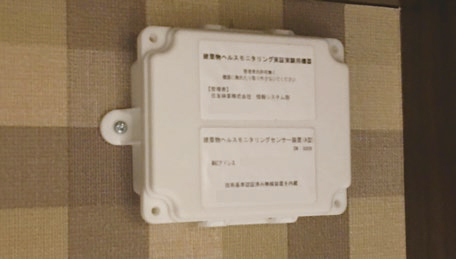
A sensor installed inside a wall of a house
Overview of How Data Is Collected
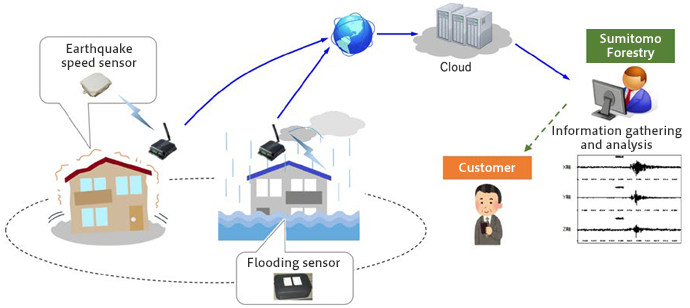
Supporting the Speedy Recovery of Home Owners and Regions Affected by Disasters
If the practical application of sensor installation in homes can be used remotely to determine the level of damage, we will be able to more quickly grasp, report and respond to the situation and arrange for repairs or other work to provide our customers the support they need. As engineers would no longer have to check each and every house on site, it would resolve the problem of taking too much time and can even be used for areas made inaccessible after a major disaster.
In addition, by utilizing this gathered data in different ways, we can develop new services that would give more people a sense of security. For example, we could collaborate with casualty insurance companies to provide quick damage assessments necessary for insurance benefits, which would help people rebuild their lives more quickly.
In addition, we could provide data to customers and local municipalities for emergency risk assessments that would help prevent secondary disasters. Furthermore, our data analysis results could promote development of technologies that enhance earthquake resistance and durability.
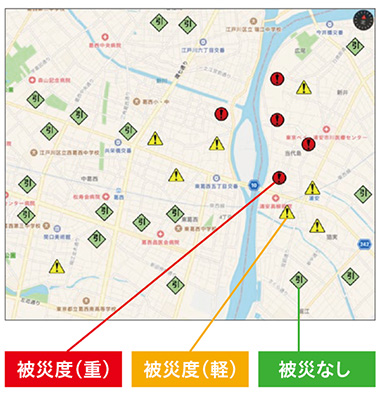
One example of how gathered data can be utilized
Housing Sales Adapted to Climate Change
"Sumitomo Forestry Homes" Resistant to Various Disasters
Sumitomo Forestry's wooden houses are characterized by their unique Big-Frame (BF) construction method. This construction method uses the principal structural members, which are about five times thicker than a regular pillar and are fixed with strong metal fittings, and this provides high seismic and wind resistance. In the seismic resistance experiment with a full-scale model of a three-story house, we have confirmed that it withstands the same level of the Great East Japan Earthquake and aftershocks that repeatedly strike. In addition, our houses can withstand winds of 88m/second, much higher than Typhoon Faxai (highest wind speed: 57.5m/second) that hit the Tokyo metropolitan area in 2019. Furthermore, in terms of fire resistance, the standard specifications are compatible with "houses with a semi-fireproof structure under the ministerial ordinance".
We ensure the safety of residents with our proprietary BF construction method that boasts outstanding strength, and with attached facilities such as a solar power generation system and rainwater tank, etc., and satisfying stockpile space which enable to live for a certain period of time until restoration even when the lifeline is interrupted. By selecting a video door phone with a network camera, residents are able to check the situation of their houses remotely in the event of a disaster. In addition, securing of stockpile space is useful for organizing belongings in the daily life, and the original built-in furniture ensures safety by preventing falls in the event of an earthquake, and can also make the room a harmonious and organized space.
Housing Using the BF Construction Method Stands Up to Disasters and Enhances Daily Comfort
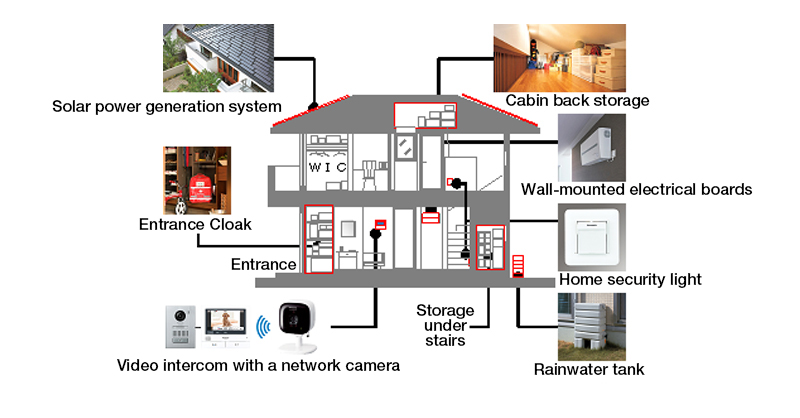
Provision of Housing That Supports "Evacuees at Home"
Many people who come through a large-scale disaster often find themselves falling ill due to the stress of living in an evacuation shelter even if they survived the disaster. It may also take days to restore lifelines such as electricity and water.
To solve these problems, there is a tactic called "evacuation living at home", using one's home as an evacuation site.
Sumitomo Forestry provides various readiness based on the seismic resistant BF construction method and ZEH performance. The high insulation efficiency of the ZEH specifications enables an energy-saving living, while securing electricity of solar power generation systems, household fuel cells, storage battery systems, etc. In addition, it supports "evacuation living at home" with various resilience-compatible specifications such as a slate roof that can handle strong winds, a short circuit fire alarm that prevents fires from a short circuit, a home security light that can also be used as a flashlight in the event of a power outage, a rainwater storage tank that can be used as domestic water when water is cut off.
Strengthening of Resilience
Sumitomo Forestry Homes have continued to demonstrate further resilience against unprecedented natural disasters with technologies leveraging the properties of wood and performance backed by a wide range of testing. Our recommended settings are with resilient materials to allow residents easier living at home after disaster strikes.
The Three Keys of Strengthening Resilience
- Seismic Resistant BF Construction Method
- Ministerial ordinance on semi-fireproof houses for fire resistance (prevents catching fire from outside or spreading fires inside rooms with wall and ceiling materials that have high fire resistance as well as a fire-stop structure)
- Roof construction with specifications to stand up to strong winds and sleeves with basal tunnels for disasters are set to ensure readiness against unprecedented disasters for its "strong rain and wind resistance".
In 2020, we included the specifications below as part of our recommendations to improve resilience performance.
- Rainwater Tank
- Slate roofs with specifications for strong winds
- Drain sleeves with basal tunnels for disaster (allows for initial recovery by putting in place a sleeve to drain water pooling in the foundation in case of below floor and above floor level flood)
- Home security lights (night lights to use as security lights during power outages, or can be removed and used as portable lights in an emergency)
- Short circuit fire alarms (sounds an alarm to alert residents of an abnormality in the event of a short circuit)
We will continue to provide safer Sumitomo Forestry Homes for home owners to feel peace of mind.
Regional Disaster Prevention in Community Development Business
Initiatives to strengthen resilience
Regarding community development project of Sumitomo Forestry, when planning a donated park according to business scale, efforts in developing donated park of which its infrastructure is insufficient in region are made to strengthen resilience between newly created "town" and peripheral existing "town." The goal is to "provide a safe and secure town not only for new residents but also for local residents." From perspective of disaster prevention, we will develop areas according to conditions of planned sites, such as open spaces where people can temporarily evacuate, facilities for distributing meals, securing water for daily life, and installing sewage manholes. Through community development projects, we will foster a sense of security in people's lives as a place for mutual assistance that "fosters connections between people and communities".
Forest Garden National Kiginosono Park
In Forest Garden National Kiginosono Park, a project of the Sumitomo Forestry Group, local governments did not have existing disaster prevention warehouses or evacuation sites. Therefore, we provided a park specialized in disaster prevention equipment as a temporary base for nearby residents to evacuate to in the event of a disaster. We have set up a disaster prevention warehouse, disaster prevention wells, manholes for sewage, furnace benches, pergola*, etc. in the park. In addition, many trees from existing thicket were transplanted to the park in order to utilize native species and reduce environmental burden. We built a park rich in nature by minimizing changes in habitat environment of insects and birds that originally lived there.
*A shelf in which climbing plants can crawl. They are often installed on a bench in a park
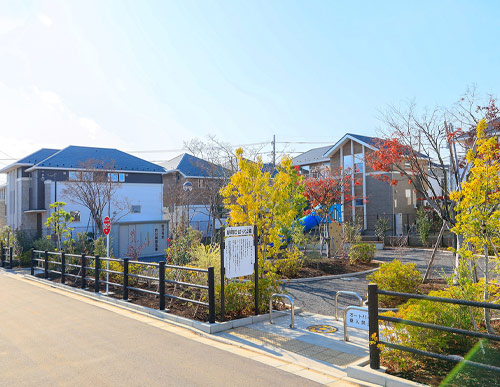
Forest Garden National Kiginosono Park
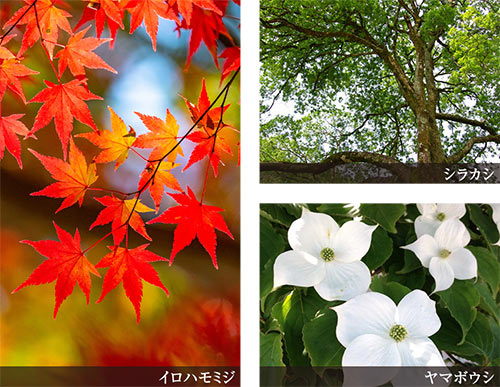
Tree species of Forest Garden National Kiginosono Park (Partial)
Approach to strengthening disaster prevention resilience
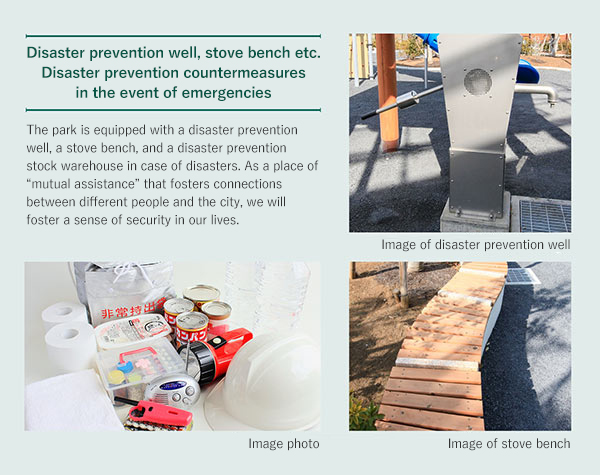
Forest Garden National Kiginosono Park
Collaborative Research on Climate Resilient Varieties
In October 2022, "Climate Change-Adaptive Breeding Project (Tropical Forest Resilience Project)" for forests in Indonesia went into full-scale operation. This project is a joint project between industry, government and academia in Japan and Indonesia. As the only private company participating from Japan, Sumitomo Forestry is working with universities and research institutions in both Japan and Indonesia to jointly research and develop varieties that are resilient to climate change, with an aim of enhancing resilience of forestry and realizing sustainable forestry.
In Indonesia, there are concerns that climate change will cause a further decrease and degradation of forests, including tropical forests. Through this project, we will develop a technology to select and increase trees adaptive to climate change for key tree species in Indonesia. Sumitomo Forestry is responsible for the propagation of selected trees and the production of seedlings using techniques such as tissue culture and cuttings. This work is based out of its manufacturing group company Kutai Timber Indonesia (KTI) and its forestation group companies Wana Subur Lestari (WSL) and Mayangkara Tanaman Industri (MTI) in Indonesia. Also, we conduct simulations of environmental changes caused by climate change, and plant selected superior trees to improve and strengthen the functions of forests as sinks and reservoirs of CO2. By cultivating forests with high adaptability to climate change, it is expected to restore ecosystem functions, establish a sustainable timber production system for the future, and bring positive effects to local communities and the economy in Indonesia.

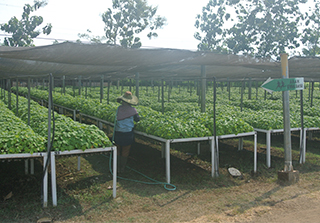
Raising seedling cultivation and planting trees at KTI
- Home
- Sustainability
- Environment
- Responding to Climate Change
- Adaption to Climate Change

